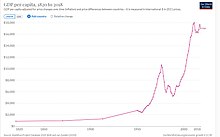| History of Iran |
|---|
 |
|
Timeline |

Prior to 1979, Iran's economic development was rapid. Traditionally an agrarian society, by the 1970s the country had undergone significant industrialization and economic modernization.[1][2] This pace of growth had slowed dramatically by 1978 as capital flight reached $30 to $40 billion 1980 US dollars just before the revolution.[3]
After the Revolution of 1979, Iran's government proceeded with 4 reforms:
- First they nationalized all industry, including the NIOC, and all Iranian banks.
- The new Constitution divided the economy in 3 different sectors, namely "State", "Cooperative" and "Private", with the majority being state-owned businesses.
- The Government started using central planning to control the economy, having the Supreme Leader, the President and Majlis creating 5-year socio-economic plans.
- The State took control of setting prices and subsidies.
The government's long-term objectives since the revolution have been economic independence, full employment, and a comfortable standard of living for citizens, but at the end of the 20th century, the country's economy faced many obstacles.[4] Iran's population more than doubled between 1980 and 2000 and grew increasingly younger. Although a relatively large number of Iranians are farmers, agricultural production has consistently fallen since the 1960s. By the late 1990s, Iran had become a major importer of food. At that time, economic hardship in the countryside resulted in vast numbers of people moving to cities.[3]
The eight-year war with Iraq claimed at least 300,000 Iranian lives and injured more than 500,000. The cost of the war to the country's economy was some $500 billion.[5][6] After hostilities with Iraq ceased in 1988, the government tried to develop the country's communication, transportation, manufacturing, health care, education and energy sectors (including its prospective nuclear power facilities), and began the process of integrating its communication and transportation infrastructure with that of neighboring states.[7]
Since 2004, Supreme Leader Khamenei and President Ahmadinejad have tried to implement reforms that will lead to the privatization of Iran but they haven't worked out yet, making Iran a command economy in transition towards a market economy.
- ^ Iran's Industrial Progresses (Part I) on YouTube. Iran National Film Centre (circa 1975). Retrieved January 20, 2010.
- ^ Iran's Industrial Progresses (Part II) on YouTube. Iran National Film Centre (circa 1975). Retrieved January 20, 2010.
- ^ a b Shirin Hakimzadeh. Iran: A Vast Diaspora Abroad and Millions of Refugees at Home Archived 2009-09-20 at the Wayback Machine. Migration information source (2006). Retrieved July 18, 2009.
- ^ Gheissari, Ali (2009). Contemporary Iran: Economy, Society, Politics. USA: Oxford University Press. pp. 7–8 (Paperback edition). ISBN 978-0-19-537849-8.
- ^ "Iran-Iraq war". Microsoft Encarta. 2008.
- ^ Iran-Iraq war (1980-1988) Archived 2011-02-28 at the Wayback Machine. Globalsecurity.org. Retrieved October 21, 2009.
- ^ "Iranian Economy in Six Snapshots". Payam-e Emruz; Economic, Social, Cultural (Monthly). February 2001. Archived from the original on September 27, 2007. Retrieved July 17, 2007.
